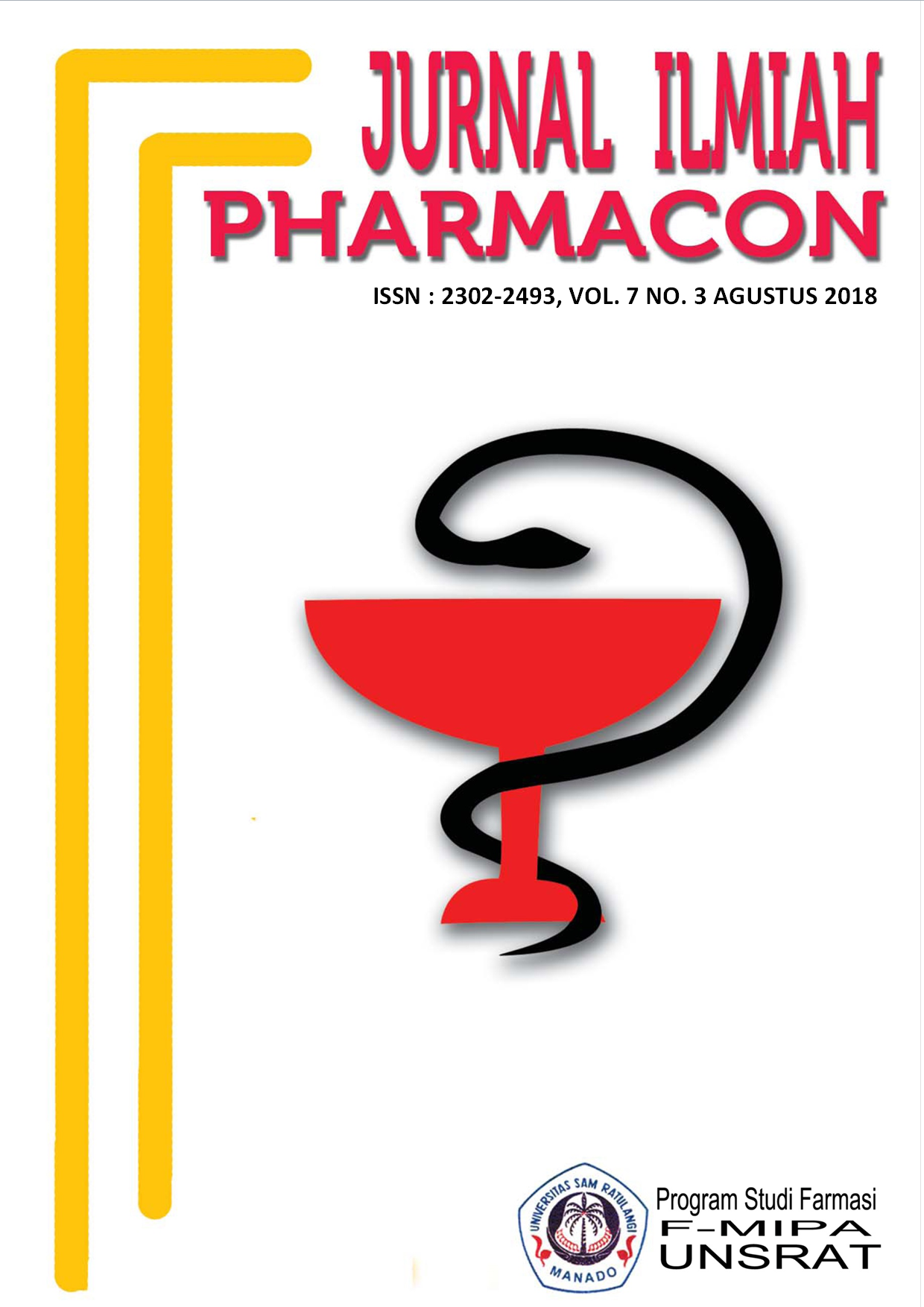PENGARUH KONSENTRASI BASIS GEL EKSTRAK ETANOL DAUN TAPAK KUDA (Ipomoea pes-caprae (L.) R. Br.) TERHADAP AKTIVITAS¬ ANTIBAKTERI PADA Staphylococcus aureus
DOI:
https://doi.org/10.35799/pha.7.2018.20477Abstract
PENGARUH KONSENTRASI BASIS GEL EKSTRAK ETANOL DAUN
TAPAK KUDA (Ipomoea pes-caprae (L.) R. Br.) TERHADAP
AKTIVITAS¬ ANTIBAKTERI PADA Staphylococcus aureus
Chyndi M.E.Salenda1), Paulina V.Y.Yamlean1), Widya Astuti Lolo1)
1)Program Studi Farmasi FMIPA UNSRAT Manado, 95115
ABSTRACT
Morning glories leaves possessed chemical contain such as flavonoids, terpenoids, steroids, saponins and tannins which act as antimicrobials and stimulate new cell growth in wounds. One of the bacteria that causes infections in the wound is Staphylococcus aureus. The objective of this study was to know the effect of base concentration gel of ethanol extract of morning glories leaves with three variation of HPMC base concentration of 1%, 2%, and 3% on the physical properties of gel preparation and it’s antibacterial activity against Staphylococcus aureus bacteria. The method used in this research is laboratory experimental. Morning glories leaves were extracted by maceration using 70% ethanol solvent and formulated into gel preparations with base concentration variations. Testing of antibacterial activity using diffusion method by means of well. The result showed that the ethanol extract gel of morning glories leaves complied with the physical properties of gel preparation which included organoleptic test, homogeneity, pH and adhesion, but does not meet the requirement in scatter test. Gel of ethanol extract of morning glories leaves of HPMC base concentration of 1%, 2%, and 3% proven to inhibiting the activity of Staphylococcus aureus with inhibition zone of 9,8 mm, 9,5 mm and 8,5 mm which belongs to medium inhibitory category.
Keywords: Morning glories leaf, base gel, Staphylococcus aureus
ABSTRAK
Daun Tapak Kuda memiliki kandungan kimia seperti flavonoid, terpenoid, steroid, saponin dan tannin yang bekerja sebagai antimikroba dan merangsang pertumbuhan sel baru pada luka. Salah satu bakteri penyebab infeksi pada luka ialah Staphylococcus aureus. Penelitian ini bertujuan untuk mengetahui pengaruh konsentrasi basis sediaan gel ekstrak etanol daun tapak kuda dengan tiga variasi konsentrasi basis HPMC 1%, 2%, dan 3% terhadap sifat fisik sediaan gel dan aktivitas antibakterinya terhadap bakteri Staphylococcus aureus. Metode yang digunakan dalam penelitian ini adalah eksperimental laboratorium. Daun Tapak kuda diekstraksi dengan cara maserasi menggunakan pelarut etanol 70% dan diformulasikan menjadi sediaan gel dengan variasi konsentrasi basis. Pengujian aktivitas antibakteri menggunakan metode difusi dengan cara sumuran. Hasil penelitian menunjukan bahwa gel ekstrak etanol daun tapak kuda memenuhi persyaratan sifat fisik sediaan gel yang meliputi uji organoleptik, homogenitas, pH dan daya lekat, akan tetapi tidak memenuhi persyaratan dalam uji daya sebar. Sediaan gel ekstrak etanol daun Tapak Kuda dengan konsentrasi basis HPMC 1%, 2% dan 3% terbukti dapat menghambat aktivitas antibakteri Staphylococcus aureus dengan zona hambat sebesar 9,8 mm, 9,5 mm dan 8,5 mm yang termasuk kategori daya hambat sedang.
Kata Kunci : Daun tapak kuda, basis gel, Staphylococcus aureus.
Â
Downloads
Published
How to Cite
Issue
Section
License
Authors who publish with this journal agree to the following terms:
- Authors retain copyright and grant the journal right of first publication with the work simultaneously licensed under a Creative Commons Attribution-NonCommercial 4.0 International License that allows others to share the work with an acknowledgement of the work's authorship and initial publication in this journal.
- Authors are permitted and encouraged to post their work online (e.g., in institutional repositories or on their website) prior to and during the submission process, as it can lead to productive exchanges, as well as earlier and greater citation of published work (See The Effect of Open Access)










